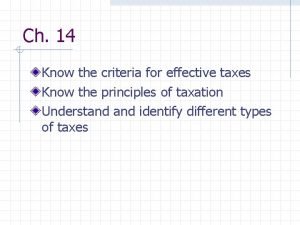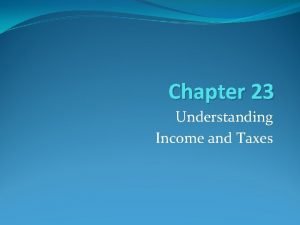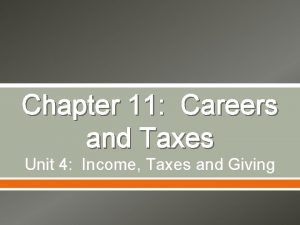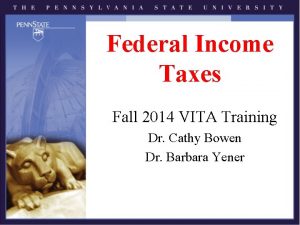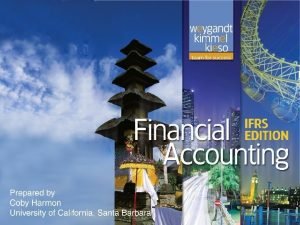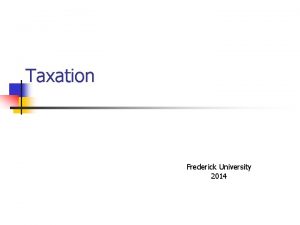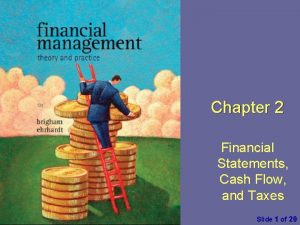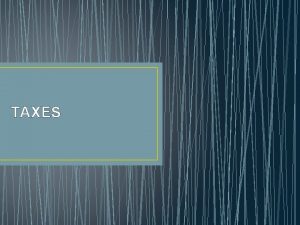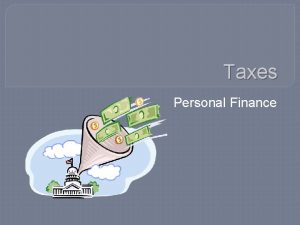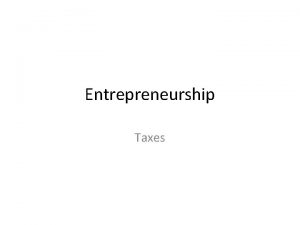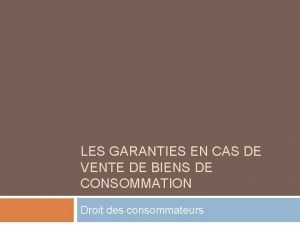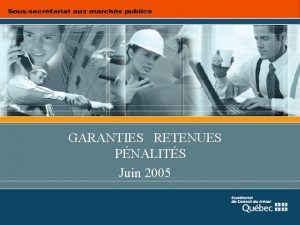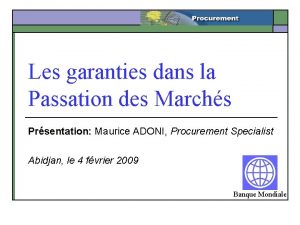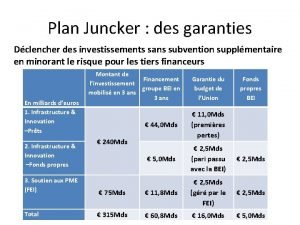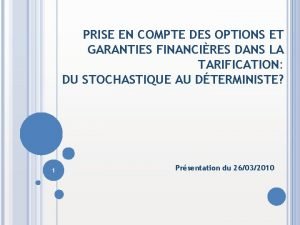Les garanties de vie Taxes Les taxes La















- Slides: 15

Les garanties de vie Taxes

Les taxes? § La taxe est une cotisation obligatoire prélevée sur les personnes, les biens ou les entreprises pour le soutien du gouvernement pour les activités économiques et sociales. En d'autres termes, c'est la somme payée à un gouvernement pour financer ses programmes et services.

Qui est responsable de cela? § Canada utilise un système d'autoévaluation pour la collection des taxes. Cela signifie que chaque individu est responsable de payer leurs taxes selon la Loi de l'impôt sur le revenu. C'est à vous de calculer combien vous devez payer de taxes sur le revenu et quels avantages vous devraient recevoir.

Pourquoi est-ce que mon salaire est-il si faible ? § Votre employeur fait des retenues sur votre salaire. § Les plus courantes sont au régime de pensions du Canada (RPC), primes d'assurance-emploi (AE) et impôt sur le revenu. § Une fois que vous avez 18 ans et jusqu'à ce que vous avez 70 ans vous devez payer des cotisations au RPC basées sur votre revenu. § La cotisations de l'assurance-emploi sont basées sur un pourcentage de votre salaire et peut changer d’une année à l'autre.

Information Importante § La déclaration de revenue de chacun est différente ! Ne supposez pas que parce que votre voisin a obtenu un remboursement que vous obtiendrez un remboursement aussi. § Connaissez vos avantages et où trouver des avantages supplémentaires ! § Il y a beaucoup d'endroits où vous pouvez obtenir des crédits d'impôt supplémentaires § Par exemple, si vous avez déménagé pour le travail ou l'école vous pouvez déduire certaines dépenses de votre revenu net donc vous économisez de l'argent ! § Vous pouvez déduire le coût d'un passe mensuel de transport public de votre revenu net ! § Vous pouvez réclamer jusqu'à 500 $ par enfant pour les programmes d'activité physique!

Maintenant on va tous faire nos taxes ensemble!

Steps to completing a basic tax return § Step 1: On Page 1 of the form T 1 General 2017 fill in the Identification Information § If you do not have a SIN (social insurance number) make one up for the sake of this exercise. § Read all descriptions of boxes carefully. You don’t want to provide inaccurate information. § If you are under 19 and will not be turning 19 by April of that year you must check NO for the GST/HST credit

Steps to completing a basic tax return § Step 2: On Page 2 of the T 1 General 2017 form you will be calculating your Total Income for that year. § In Box 101 – Enter the total amount of employment income. This is the sum of all the amounts of Employment Income from any T 4 slips that you received. § If you received any other sources of employment income (ie. Tips) you must enter those in box 104 § Be sure to go through each line and see if any areas apply to you (For example, Interest and other investment income, or Universal Child Care Benefit, or Self-Employment Income § Don’t mix CPP benefits or Employment Insurance benefits with the amounts listed on your T 4. You need to make sure the box numbers and descriptions all match!

§ Step 3: On Page 2 of the T 1 General 2017, add all of the amounts listed in the right hand column for your Total Income. Enter this final amount in Box 150 at the bottom of the page. This is not your net income for the year. § Step 4: Copy the amount from Box 150 on the BOTTOM of page 2 into Box 150 at the TOP of page 3. Page 3 is where we find deductions used to calculate your Net Income for the year. § Step 5: Go through lines 207 to 233 carefully to see if there any benefits that are applicable to you. There may not be any.

§ Step 6: Subtract the total amount from line 233 from line 150. If you have no deductions on line 235 then enter the same amount from line 233 in line 236. This is your Net Income. § Step 7: See if there any other deductions that apply to you in the Taxable Income section. If there are none, enter the amount from line 236 into line 260. This is your Taxable Income.

§ Step 8: Remove Schedule 1 from the Forms 2017 booklet. This is used to calculate your Federal Tax for the year. § Step 9: You will first calculate the Tax Credits that you will receive for that year. This is found in lines 300 to 378 (note: some numbers are skipped) § Step 10: Everyone is given a basic federal amount of $11, 038. Enter this amount on line 300. Go through the remaining lines and see if there any other tax credits that are owed to you. § Most people will find they have CPP Contributions (Line 308) and EI Premiums (Line 312) that can be included. These amounts are found on your T 4’s. § You can also claim the Canada Employment amount if you entered employment income on line 101. Enter the lesser of $1, 117 and the total employment income from line 101 and 104 combined. § If you are unsure about whether or not you can claim a tax credit refer to the General Income Tax and Benefit Guide.

§ Step 11: Add up the amounts from line 300 to 332 and enter the result on line 335. Multiply line 335 by 15% and enter this amount on line 338. If you have no donations or gifts to declare, enter the same amount on line 350. This is your total federal tax credit. § Step 12: Enter the taxable income amount from line 260 of the T 1 General into the appropriate space (line 38) of Schedule 1.

§ Step 13: Find the appropriate table for your taxable income and complete the calculations to find the amount to enter into line 45. Enter this amount on line 46 and if the following line (Federal tax on split income) does not apply enter the same amount on line 48. § Step 14: Enter the amount from line 37 onto line 49. If no other credits (lines 50 – 52) apply then enter the same amount on line 53. Subtract Line 53 from Line 48 to calculate your Basic Federal Tax. If the amount on line 54 is negative then the basic federal tax is 0. § Step 15: If the basic federal tax is zero, Enter 0 on lines 62 and 65 and Schedule 1 is complete.

§ Step 16: Enter the amount from line 65 of Schedule 1 into Line 420 on page 4 of the T 1 General form. Add lines 420, 421, 430, 422, 428 and enter this in line 435. This is your total payable amount. § Step 17: In line 437 enter the sum of the Income Tax Deducted as listed in box 22 of any T 4 slips. Add lines 437 to 479 (Note: numbers missing) and enter the total in line 482. This is the Total Tax Credit that you have. § Step 18: Subtract Line 482 from line 435. If the total is negative you have a tax refund. If it is positive you have a balance owing. If the amount is $2. 00 or less no refund is paid out and no balance owing must be paid. § Step 19: Sign and date in the appropriate box at the bottom of Page 4. YAY!

Time to complete your own! § You all have been given a T 4 statement. You will use this to complete a basic tax return. If you wish to be a bit more advanced you can use any random events that impacted you financially for which you may receive tax credits (IE Moving expense, Tuition costs, Transit expense, etc). § Your completed Tax Return will be submitted in your final Financial portfolio.
 Haribo c'est beau la vie pour les grand et les petit
Haribo c'est beau la vie pour les grand et les petit Je crois que ce sont les petites choses
Je crois que ce sont les petites choses Les trains de la vie
Les trains de la vie Les choses simples de la vie
Les choses simples de la vie Fin 18 interim tax provision
Fin 18 interim tax provision Elmira city school district calendar
Elmira city school district calendar 3 criteria for effective taxes
3 criteria for effective taxes Chapter 23 understanding income and taxes
Chapter 23 understanding income and taxes Foundations u disc profile
Foundations u disc profile Understanding taxes
Understanding taxes Income tax expense
Income tax expense Fin 360
Fin 360 Tax payable in cash flow statement
Tax payable in cash flow statement Loss contingency journal entry
Loss contingency journal entry How many types of taxes are there
How many types of taxes are there Total net operating capital
Total net operating capital






